Screw sizes are a mystery to most people so we have tried to make life a little easier with the metric imperial screw conversion chart below.
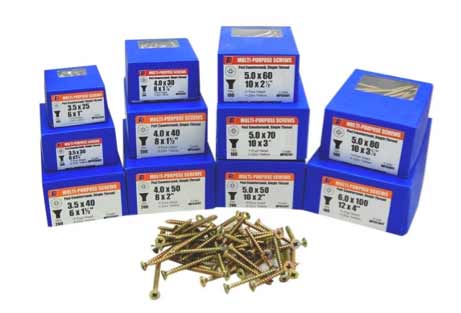
Selection of multipurpose screws
Metric and Imperial Screw Sizes
Most manufacturers put both the metric and imperial size on the box of screws which is very helpful, however when purchasing online, many retailers do not. This is largely because the title of the product becomes too long and cumbersome, so something has to go. Whether you deal in old or new money, as it were, you still need to know what you are getting. This is the difference between the two and what you need to look for:
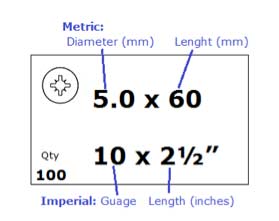
Screw sizes as marked on the lable of most products
Imperial Screw Sizes Explained
A wood screw is sized by two different numbers. First is the Gauge of the screw which refers to the diameter – the larger the number, the larger the diameter. A number 4 screw is much smaller than a number 12 screw.
It is worth noting that there is no direct link here between the head size of an imperial screw and the gauge of that screw. It is purely coincidence that, from screw gauges 6- upwards, that the gauge is close to twice the head diameter although some sources would have you believe this is how the gauge is calculated.
The length is given next and it should be remembered that the length given for a screw is the length that is buried in the wood or other material, it does not include the head of a raised, or domed headed screws.
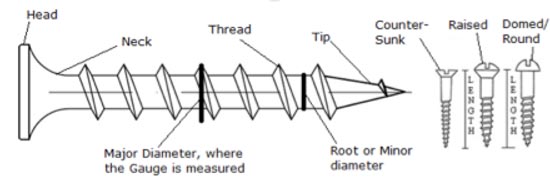
Screw size is determined by gauge and length
These are the basics to know when looking at screw sizes but to find out more about the thread of screws and other items you can look at Wikipedia. There’s a lot to learn if you’re interested!
Metric Screw Sizes Explained
As you can imagine, the metric system is a little simpler to understand for the uninitiated however if you’re not used to it, or still working in Imperial it can be a little tricky.
Rather than use a “Gauge” figure, the metric system uses the (major) diameter in millimetres. The length is also measured in millimetres and exactly the same as it is for the imperial system.
As a handy coincidence, the Gauge (imperial) roughly equals the screw head size in millimetres. A 4 gauge screw will have a head that is approximately 4mm wide.
This is actually quite complicated, as was pointed out by Paul, one of our readers! Here is a more concise explanation of the relationship between gauge (imperial), diameter (metric in mm) and Head size.
The gauge (imperial) is half the imperial diameter (in 16th of an inch) of the screw head, roughly. The precise relationship of imperial screw head sizes and the gauge can be calculated. The formula is as follows:
(Head diameter in sixteenths is an inch X 2 ) – 2 = Gauge. E.g. 5/16 head times two equals 10, minus two equals 8. The Gauge is 8.
Above we explain that the Gauge (imperial) happens to have a head which is approximately the same number (in mm). This is the equivalent of saying that the diameter in mm is approximately half the gauge (given what the formula above states).
Don’t worry if you don’t follow this as not many people know about these relationships, let alone use them.
More about Screws
Slotted screws are fast becoming history and cross head screws are now the fashion but it must be remembered that a cross head screw can either be a Philips screw (top image below)or a pozidrive/supadrive screw (bottom image below). They both require a different type of driver which can be found below.
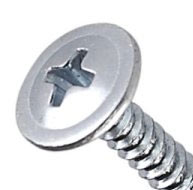
Phillips head screw

Pozidrive head screw
Although technically you can use a Phillips driver on a Pozidrive screw and vice versa, their not really designed to fit and under torque load (when you are screwing the screw in) in pretty much all situations it will slip and damage the head of the screw making it difficult to either screw in the screw or remove it, so it’s always best to use the right tool for the job.
These are the most commonly used screws nowadays, but there are great deal more so if you are not sure about which types of screws to use, see also our projects on different types of screw, We also have a great project on how to countersink.
If you need to make sure that you have the right size screw for the job, then please read on below.
Metric Imperial Screw Conversion Chart
Please use this table to match the metric size to the imperial screw size. Please remember that the conversion is not exact, but this is generally not a problem and the margins of error are generally considerably less than your own measurements.
| Diameter (mm) | Length (mm) | Closest Imperial Size Gauge x Length |
| 3mm | 12 | 4 x 1/2 |
| 16 | 4 x 5/8 | |
| 20 | 4 x 3/4 | |
| 25 | 4 x 1 | |
| 30 | 4 x 1 1/4 | |
| 40 | 4 x 1 1/2 | |
| 3.5mm | 12 | 6 x 1/2 |
| 16 | 6 x 5/8 | |
| 20 | 6 x 3/4 | |
| 25 | 6 x 1 | |
| 30 | 6 x 1 1/4 | |
| 40 | 6 x 1 1/2 | |
| 4mm | 12 | 8 x 1/2 |
| 16 | 8 x 5/8 | |
| 20 | 8 x 3/4 | |
| 25 | 8 x 1 | |
| 30 | 8 x 1 1/4 | |
| 35 | 8 x 1 3/8 | |
| 40 | 8 x 1 1/2 | |
| 45 | 8 x 1 3/4 | |
| 50 | 8 x 2 | |
| 60 | 8 x 2 3/8 | |
| 70 | 8 x 2 3/4 | |
| 4.5mm | 25 | 9 x 1 |
| 30 | 9 x 1 1/4 | |
| 35 | 9 x 1 3/8 | |
| 40 | 9 x 1 1/2 | |
| 45 | 9 x 1 3/4 | |
| 50 | 9 x 2 | |
| 60 | 9 x 2 3/8 | |
| 70 | 9 x 2 3/4 | |
| 75 | 9 x 3 | |
| 5mm | 25 | 10 x 1 |
| 30 | 10 x 1 1/4 | |
| 35 | 10 x 1 3/8 | |
| 40 | 10 x 1 1/2 | |
| 45 | 10 x 1 3/4 | |
| 50 | 10 x 2 | |
| 60 | 10 x 2 3/8 | |
| 70 | 10 x 2 3/4 | |
| 75 | 10 x 3 | |
| 80 | 10 x 3 1/4 | |
| 90 | 10 x 3 1/2 | |
| 100 | 10 x 4 | |
| 6mm | 30 | 12 x 1 1/4 |
| 40 | 12 x 1 1/2 | |
| 50 | 12 x 2 | |
| 60 | 12 x 2 3/8 | |
| 70 | 12 x 2 3/4 | |
| 75 | 12 x 3 | |
| 80 | 12 x 3 1/4 | |
| 90 | 12 x 3 1/2 | |
| 100 | 12 x 4 | |
| 110 | 12 x 4 3/8 | |
| 130 | 12 x 5 1/8 | |
| 150 | 12 x 6 |
If you are working the other way, or trying to find the metric screw size from an imperial measurement then you can use this table. We have add the sizes for the pilot holes and rawl plugs that are generally used.
| Gauge | Metric diameter (mm) | Pilot Hole size (mm) | Masonry Rawl Plug | Hole size for Rawl Plug (mm) |
| 3 | 2.5 | 1 | Yellow | 5 |
| 4 | 3 | 1.5 | Yellow | 5 |
| 6 | 3.5 | 2 | Red | 6 |
| 8 | 4 | 2.5 | Red (or Brown) | 6 (or 7) |
| 10 | 5 | 3 | Brown | 7 |
| 12 | 5.5 | 3.5 | Brown | 7 |
| 14 | 6.5 | 4 | Blue | 10 |
What Size Spanners for ISO Metric Threaded Nuts and Bolts
For coach screws, which have a hex head the size (as opposed to the length) is quoted as an ISO Metric Thread. This is the number starting with an “M”. These numbers describe the thread and relate to the size of the wrench that should be used on them. Find out more about wrenches here, but here are the common thread sizes and their corresponding Spanner or wrench size.
| ISO metric thread | Spanner size (mm) |
| M1.6 | 3.2 |
| M2 | 4 |
| M2.5 | 5 |
| M3 | 5.5 |
| M4 | 7 |
| M5 | 8 |
| M6 | 10 |
| M8 | 13 |
| M10 | 17 |
| M12 | 19 |
| M16 | 24 |
| M20 | 30 |
| M24 | 36 |
| M30 | 46 |
| M36 | 55 |
| M42 | 65 |
| M48 | 75 |
| M56 | 85 |
| M64 | 95 |
If you are struggling to find the best way to get your screw into whatever you are screwing, then have a look at our project that explains all about screwdrivers.
The sizing of screws in one of the most challenging things, but there are also a huge variety of different kinds of screw that can be used for a wide range of different job.
It is always best to get the right type of screw for the job, so we have written a project specifically about this. Have a look here for our project on the different kinds of screw you can buy.
In most cases, it is also very handy to know the different parts that make up a screw and the types of head and thread available, for information on this see our parts of a screw project here.
The M Rating or M Measurement for Screws and Bolts
On some screws and bolts you will see an M followed by a number.
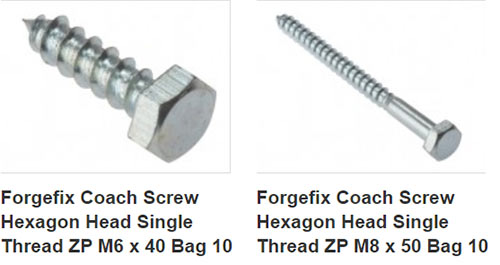
M Ratings of Screws show the diameter of the screw
The M apparently stands for Metric which sounds plausible, although we cannot verify this. What it indicates however it that the number following it is the diameter of the screw (or bolt) in millimetres.
In the examples shown above, the M6 is a 6mm wide screw (at the threaded part, not the head) and the M8 is 8mm wide.
Other Acronyms and Abbreviations used to Describe Screws
There are a range of acronyms and letters that you often find on screw boxes or in their online descriptions. Here is a summary of the most common, and what they mean:
- ST – Self Tapping; These screws have a tip that will allow them to be screwed into (typically wood) without a pilot hole being drilled. This saves a lot of time!
- TT – Twin thread
- TFT – Twin Fine Thread
- ZP – Zinc Plated; These screws have been plated with zinc to stop them becoming corroded
- ZYP – Zinc and Yellow Passivated; Zinc plated to reduce susceptibility to corrosion and then a passivation layer is applied to the zinc coating to give it even more corrosion protection; this typically results in a yellow colour

